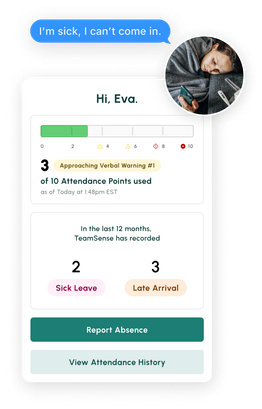Fix the root cause of No-Call No-Show with help from TeamSense
Table of Contents
- What is Paid Time Off (PTO)?
- Advantages of a Paid Time Off Policy
- Potential Drawbacks of a PTO Policy
- How Does a PTO Policy Work?
- Factors to Consider While Drafting a PTO Policy
- How to Create the Right PTO Policy for Your Company, Step-by-Step
- Step 4: Distribute and Communicate Your PTO Policy
- Example of an Accrual PTO Policy
- How Can You Track PTO?
- Final Thoughts
Crafting a PTO policy is about more than just outlining a process for jotting down some days off— it's about understanding the heartbeat of your company and the rhythm of your employees' lives. And, in the bustling world of manufacturing, where every second counts, having a clear-cut PTO policy mapped out for your hourly employees can make all the difference between a team that’s raring to go and, well, a few operational hiccups!
If you're feeling uncertain about where to begin or how to align policy details with real-world needs, no worries; you’ve landed in just the right spot! Together, we’re going to explore the ins and outs of creating a PTO policy that’s a win-win for both the company and the awesome folks who make it all happen while ensuring everything’s in tune and crystal clear for everyone!
What is Paid Time Off (PTO)?
Traditionally, leave was split into categories like vacation, sick, and personal days. But PTO lumps all these together in one bucket. This gives your team members the freedom to decide when and why they'll use their PTO.
To give you a clearer picture, here are some examples of what PTO offerings you should consider adding to your policy:
National holidays: Think of the big ones like Christmas and Independence Day. If your facility is open 24/7, 365, or operational on weekends, it’s important to clearly state in your PTO policy how paid time off works for all holidays. Do they get time and a half if they are scheduled to work? Or can they bank an extra PTO day for coming in? (Known as a “floating holiday”.) You want to create a policy that is fair for everyone and fosters a positive company culture. Keep in mind that if your facility is closed on weekends or odd days, you’ll need to clarify how you’ll treat the holidays that fall on those days.
Jury duty: Important civic duty, right? Be clear on whether this is paid and what paperwork they might need to show.
Personal time: Whether it's for a doctor's visit or their kid's soccer match, a flexible PTO lets them manage personal commitments without stress.
Sick time: Illnesses happen. A PTO system helps ensure the team doesn't come in sick, which is especially critical in close-quartered environments like warehouses and manufacturing facilities.
Community service: Boost your company's goodwill. How about offering time off for volunteering or community service that aligns with our brand's ethos?
Bereavement leave: Life has its sad moments too. Support your team members when they need time to grieve and remember loved ones.
Maternity and Paternity Leave: Welcoming a new member to the family is a big deal! Ensure your employees have time to bond and adjust.
Medical leave: Including medical leave in PTO policies ensures compliance with legal requirements such as the Family and Medical Leave Act (FMLA) and showcases a commitment to your employees.
Advantages of a Paid Time Off Policy
At its core, a PTO policy makes life easier for everyone. HR gets a streamlined process, and your team gets clarity and flexibility.
- Easy for HR to Manage. HR’s got enough on their plate. A clear PTO policy means one less headache.
- Flexibility. PTO policies allow employees to use their time off as they see fit. This flexibility in utilizing PTO can enhance employee morale and job satisfaction and promote a positive work environment. By offering flexibility in PTO, employers prioritize the well-being and satisfaction of their employees.
- Reduced Absenteeism. With clear guidelines, you can ensure that everyone knows when and how to take time off. You must define what PTO means for your organization and how it accrues and is used.
Potential Drawbacks of a PTO Policy
Like all things, PTO policies have their challenges. Beware of employees saving up too much PTO. Also, since PTO merges vacation and sick days, there might be times when team members feel they’re getting the short end of the stick.. Your task is to tailor the PTO policy, so it’s a win-win for everyone.

How Does a PTO Policy Work?
A well-crafted PTO policy can benefit both the employer and employee, leading to a more productive and content workforce. It can also greatly affect your team’s job satisfaction and work-life balance.
PTO Accumulation and Usage
Typically, PTO accrues based on the length of an employee's service with the company, meaning employees may earn a certain number of hours or days per month or year worked. For example, an hourly employee could accrue four hours of PTO for every 40 hours worked, meaning they would earn one day off every two weeks. Unless capped, PTO days continue to accrue until the employee uses them.
PTO Roll-Over and Cash-Out Policies
Some PTO policies allow employees to carry over any unused PTO hours to the next year; others may have limitations on the amount of rolled-over PTO; and certain policies may implement a cap on the total amount of PTO that an employee can accumulate. At the end of the year, cash-out options may be available for any unused PTO. The average rollover limit for PTO was determined to be 19 days in a study by the Society for Human Resource Management.
PTO for Part-Time Employees
In general, part-time employees may accrue PTO at a prorated rate based on their hours worked. You should clearly communicate the details of the PTO policy to part-time employees, including how their PTO accrues and any limitations or restrictions that may apply.
Payouts at Termination
A PTO policy should indicate whether voluntary or involuntary terminations qualify for a payout of unused PTO. Employees may need to meet specific criteria. Additionally, state laws may dictate the requirements for PTO payouts.
Factors to Consider While Drafting a PTO Policy
Before diving in, think of your specific needs. What works for a tech startup might not fit a manufacturing plant. Similarly, industries with demanding schedules or seasonal peaks may require tailored PTO policies to ensure operational efficiency. You must find a balance between meeting employee needs for time off and maintaining productivity in accordance with the unique characteristics of your organization.
Some hourly employees may prefer a structured approach to their time off, while others value flexibility. It's important to figure out the impact of unscheduled absences on workload and team dynamics. Talk to your team to understand their desired PTO arrangements and try to create policies that promote a healthy work-life balance and support employee well-being.
Also, consider allowing employees to take PTO in smaller increments, such as one hour, to provide them with more flexibility in managing their time off.
How to Create the Right PTO Policy for Your Company, Step-by-Step
Before creating your PTO policy, take some time to evaluate your company's specific requirements. Consider factors such as the size of your business, industry demands, and any unique challenges you may face.
Step 1: Choose a Type of PTO Policy
One option is the accrued PTO method, where employees earn PTO based on the hours they work. Another approach is the unlimited PTO policy, which provides employees with the flexibility to take time off as needed. A PTO rollover option allows unused PTO to carry over into the next year. By selecting the right type of PTO policy, employers can promote work-life balance and cater to their employees' needs.
Accrual Method: Ties PTO to hours worked. So the longer someone’s with the company, the more PTO they earn. PTO balances may have caps or thresholds, and the policy should spell out how accruals are calculated and tracked.
Unlimited PTO: Sounds wild, but it's about trusting your team to decide how much time off they need. To ensure fair and reasonable use, encourage employees to plan and communicate their time-off in advance. The policy should clearly address any limitations or restrictions on unlimited PTO.
PTO Rollover Option: Employees have the option to carry over their unused PTO into the next year, but there may be limitations on the amount that can be rolled over. The policy should clearly outline the process and deadlines for requesting PTO rollover.
Use-it-or-Lose-It Option: An employee must use all of her PTO within the same calendar year. Any unused PTO will be forfeited at the year-end. This approach is commonly implemented to promote work-life balance and discourage PTO hoarding.
Step 2: Legal Considerations
Federal and state laws play a crucial role in Paid Time Off (PTO) policies. The Family and Medical Leave Act (FMLA) provides eligible employees with job-protected leave, including parental leave, and some states have specific laws related to sick leave, parental leave, and other types of leave. Understanding and adhering to these laws is essential for fair treatment of employees, maintaining a positive employer-employee relationship, and ensuring that new parents have the opportunity to take paid family leave to bond with their child.
Regularly updating the policy is necessary to align it with changing laws. Conducting audits can help ensure the consistent application of the policy. By maintaining compliance, you can build trust and avoid legal conflicts.
Step 3: Write your PTO Policy
First things first, figure out how many PTO days your team members are eligible for. Lay out who can tap into the PTO perks and how they should go about asking for some time off. Oh, and if there's a heads-up period they need to give, make sure to spell it out. Don’t forget to mention any special conditions or ifs-and-buts about using PTO.
Determine the Number of Days Off
Sneak a peek at what other companies in your industry offer their hourly employees. Also, keep an ear to the ground and see how your hourly employees feel. After all, you want to strike a balance - you need operations running smoothly, but you also want your folks refreshed. And hey, don’t forget to check in with legal to see if there are any minimum days you need to offer. We'll want to revisit this every so often to make sure we're keeping up with the times. Did you know that in 2021, the Bureau of Labor Statistics found out that a good chunk of folks in private businesses had about 10-14 paid vacation days after their first year? Cool, right?
PTO Guidelines
Alright, let's get down to brass tacks. How does one even accumulate PTO in your setup? You should have a no-surprises approach to approving PTO requests. If there are any special rules about carrying over or even converting unused PTO to cash, lay it out. Oh, and if you’re offering extra goodies like bereavement or parental leave, make that clear, too. A heads-up, like a two-week notice, is pretty common so everyone can gear up for a team member's time away.
Exceptions
Every rule has its exceptions, right? In our world of manufacturing and logistics, there will be super-busy periods where you need all hands on deck, so PTO could be a no-go. And then there's the puzzle of part-timers or our newbies – how does PTO work for them? What about someone going on a long medical leave? Oh, and in the not-so-fun scenario of someone leaving us, how do we handle their PTO? Be sure to spell it all out, so there are no doubts or misunderstandings.
Step 4: Distribute and Communicate Your PTO Policy
Alrighty, once you’ve ironed out your PTO policy, it’s time to spread the word! Whether it's a quick email blast, a post on your company portal, or adding it to your employee handbook, make sure everyone's in the loop. You could incorporate the PTO policy into the onboarding process for new employees. Maybe even host a fun little info session or workshop – just to make sure everyone's on the same page.
Keep it straight and simple. Using real-life examples could really help clear things up. And keep an eye out for any legal updates or industry trends. Keeping your PTO policy up-to-date ensures you’re looking out for your hard-working hourly team!

Example of an Accrual PTO Policy
Before you jump into the nitty-gritty of creating your very own policy, let’s take a peek at an example to get the ball rolling! Below, you’ll find a sample of an accrual-based PTO policy, whipped up, especially for hourly employees in the manufacturing industry. This sample policy will help you define how time off is earned, used, and managed, all while keeping a happy balance between what the team needs and keeping the gears running smoothly.
Title: [Your Company Name] Paid Time Off (PTO) Policy for Hourly Employees
1. Policy Overview:
At [Your Company Name], we recognize the importance of rest and relaxation for the well-being and productivity of our employees. Our PTO policy is designed to offer hourly employees the flexibility to take time off for various reasons while ensuring the smooth operation of our manufacturing processes.
2. PTO Accrual:
All eligible hourly employees will accrue PTO at a rate of one hour for every 30 hours worked.
Employees can start using accrued PTO after 90 days of employment.
The maximum PTO accrual is 120 hours.
3. PTO Usage:
PTO can be used for vacation, personal time, illness, or time off to care for dependents.
PTO requests must be submitted at least two weeks in advance and approved by the supervisor. In cases of illness or emergency, employees should notify their supervisor as soon as possible.
PTO is to be used in increments of no less than one hour.
4. Holiday Pay:
Hourly employees will receive holiday pay for company-observed holidays, provided they have worked the day before and the day after the holiday.
5. PTO Carryover:
Employees may carry over a maximum of 40 hours of unused PTO to the next calendar year.
Any PTO above 40 hours at the end of the calendar year will be forfeited.
6. PTO Payout:
Upon termination of employment, hourly employees will be paid out for any unused PTO, provided they are in good standing and have provided at least two weeks' notice.
7. PTO Scheduling and Conflicts:
While we make every effort to accommodate PTO requests, approval is based on operational needs.
In the event of conflicting PTO requests, preference will be given based on seniority and the date the request was submitted.
8. Unplanned Absences:
Consistent unplanned absences can affect the efficiency of our operations and the workload of other employees. Excessive unplanned absences may lead to disciplinary action, up to and including termination.
9. Policy Modification:
[Your Company Name] reserves the right to modify this PTO policy at any time, with notice to all affected employees.
You’ve made it through the example policy! Feeling more equipped? We hope so! Remember, this is just a springboard for you. Mull over the specifics of your company, chat with your team, and see what makes the most sense for everyone. It’s all about mixing and matching until you find that sweet spot that feels just right for your organization. Have fun with it, gather feedback, and don’t be afraid to tweak things here and there. After all, creating a PTO policy is just as much about your people as it is about the policy.

Boosting Efficiency: A 3PL Company Slashes Absenteeism by 39% with TeamSense
TeamSense changed the way this 3PL handled absenteeism, resulting in significant improvement in absenteeism rates, and can help your company too!
How Can You Track PTO?
Tracking PTO accurately is just as crucial as having a solid policy in place. Accurate tracking ensures that both employees and management stay on the same page about time off, preventing any misunderstandings and potential disputes. Here are some tried-and-true methods that HR managers can utilize:
Paper Trail: Good old-fashioned paper forms can be used for employees to request and record their time off. This method involves employees filling out a PTO request form and submitting it to their supervisors or HR for approval. Once approved, it's filed away for future reference. However, while this method is straightforward, it can become cumbersome and disorganized as the company grows.
Excel Spreadsheets: Many HR managers swear by Excel for its simplicity and flexibility. You can create a master spreadsheet with tabs for each month or each employee. Columns can detail dates, type of leave, days taken, and days remaining. The beauty of Excel is the ability to use formulas to auto-calculate days left and generate monthly or yearly reports. Just remember to back up your data and ensure that the spreadsheet doesn't become too complex over time.
Dedicated PTO Tracking Software: There's a range of software specifically designed for tracking PTO. These tools allow employees to request time off electronically, with HR or managers approving in real-time. TeamSense is an outstanding attendance management platform that offers precise absence tracking, automated reports, integration with HR and payroll systems, and a comprehensive toolset for managing attendance.
Calendar Integrations: Tools like Google Calendar or Microsoft Outlook can be used to track PTO. Whenever an employee takes a day off, it's marked on the shared calendar, visible to the relevant teams. This method provides a visual representation of who’s off and when, aiding in planning and coordination.
Mobile Apps: With the increasing use of smartphones, several PTO tracking apps are available on app stores. These apps allow employees to request and view their PTO from anywhere. Notifications, reminders, and summaries make the process smooth for both the employee and the manager.
HR Management Systems (HRMS): Comprehensive HR platforms often come with a built-in PTO module. If your company uses an HRMS, delve into its features to see if it supports PTO tracking. These systems are particularly beneficial for larger organizations or those with complex PTO policies, as they offer a centralized place for all HR-related tasks.
When choosing a method, consider the size of your organization, the complexity of your PTO policy, and the resources available. Remember, the key is to maintain clarity and transparency for everyone involved.
Final Thoughts
So, when we talk about nailing down a PTO policy, especially for an hourly crew, it's all about getting the mix just right. Think of it like blending your industry experience, catching up with your team for their two cents, and tailoring everything to your company's unique situation. But here's the thing - don't just set it and forget it. Keep tweaking things as you go along. When you’re on top of your PTO game, it translates to a more vibrant, motivated team, smoother operations, and just a great place to work! As you keep refining things, always remember what you stand for and keep looking out for your hard-working hourly folks. 👍

About the Author

Sheila Stafford, CEO of TeamSense & AI in HR Innovator
As CEO of TeamSense, Sheila Stafford is at the forefront of transforming HR for frontline teams through AI-driven solutions. With a commitment to enhancing employee relations and simplifying workforce management, Sheila leads TeamSense in pioneering advancements that empower both frontline employees and HR teams. Her visionary approach combines cutting-edge technology with a thoughtful focus on enhancing human connection; Sheila strategically implements AI where it adds the most value while recognizing the critical role of personal interaction and ensuring that human engagement remains central when it matters most. Under her leadership, TeamSense is redefining how companies support and engage their frontline teams for a more connected, efficient workplace.





